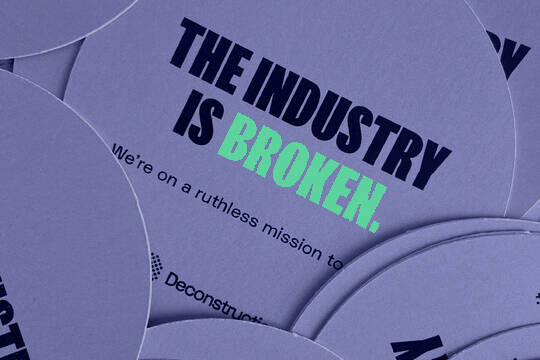Before I cite one of the best branding projects of the last decade (in my opinion), it may be worth visiting the perceptions of good branding and what that actually means. I’m not here to try to teach my peers how to suck eggs, and I’m pretty sure those branding specialists out there would maybe argue that my points of view are unfounded and somewhat personal. Okay… I accept that. However, I do know good branding when I ‘see’ it and therefore I am going to base my judgement on that.
Let’s start why I wrote ‘see’ in single quotes in the previous paragraph.
To quote Jeff Bezos (and subsequently my colleague Josh Heaton), “brand is what people say about you when you’re not in the room.” It’s a valid observation, and it tells us that what you ‘see’ isn’t where branding ends – or necessarily where it begins – regardless of what you see being good or bad.
Behind the scenes
Behaviour is a big part of branding. Just recently, I was chatting with my friend who works for a large and well-respected retail organisation. We got onto the subject of customer service, and I was horrified to learn that the whole process from ordering through to installation of the product and after-care was handled by so many different departments and staff, that customer experience and reviews were running into major negative numbers.
Customers were being left on-hold for unacceptable lengths of time. Orders were taking longer to process. Members of staff were unaware of certain orders and therefore customers had to reiterate information two, three and even four times having been passed from one department to another.
The company in question is now working to establish a more streamlined system, whereby customers have a dedicated project manager to ensure complete transparency, and a joined-up process to help eradicate any order integrity issues.
Ultimately, this will help reverse the bad reputation of the brand in question and take it to the level of trust and quality it once owned.
This had nothing to do with a logo or a strapline – this was a brand in trouble purely on behaviour.
Great logos don’t make great brands
Logos are like children, we can be so close to them and love them so much, that we turn a blind eye to problems they may be causing behind the scenes. So yes, you could have a the most adorable, perfectly dressed and pampered child in the world, but if they’re murdering the cat while you’re out at work, then something needs to be done.
It’s also worth noting that creating the logo of your dreams before you’ve done any groundwork, is unlikely to meet the values that you want to convey. And it’s a dead cert that someone will ask you what your logo means – so, the answers better make sense.
Therefore, it’s worth biting the bullet if your brand isn’t working as hard as it should be, and do some digging to find the answers, whilst collating all the good points to help determine a more positive result. It would be a similar process to sending your cat-murdering child to therapy.
Interviews should be set up to collate information regarding the perception of the brand, its name, its identity, its behaviours and its successes and failures. This should be a process which includes internal personnel as well as external stakeholders. Think about your competition too. Find out what makes them successful – or indeed struggling to survive.
Which segues nicely into the main event. Eurostar’s new branding.
![eurostar_2023_logo_before_after[35] 1 eurostar 2023 logo before after35](https://www.slg.agency/wp-content/uploads/2024/01/eurostar_2023_logo_before_after35.png)
Star insight
It’s fair to say that Eurostar did its homework with this one. Not only did it ensure it researched the equity in its brand with stakeholders, but it went a step further, gaining insight to its own future.
Getlink owns the tolls for the tunnel that Eurostar uses, so, in short, the more trains and passengers through the tolls, provides more revenue for Getlink. Apparently, it’s no secret, therefore, that Getlink wants competition for Eurostar – the majority of which is owned by SNCF, the French rail giant.
Jacques Gounon, director of Getlink, believes that Eurostar could no longer be alone in this market. Gounon said: “I will buy them and then rent them [the locomotives and rolling stock]. This reduces the issue of fixed costs and the technical barrier.”¹
This will inevitably attract competition with new trains and carriers wanting a piece of the action. The Spanish carrier Renfe is currently interested because it already competes with SNCF on its domestic network.¹
Star quality
There are many reasons Eurostar has decided to rebrand, the aforementioned monopoly threat is one of them. However, further activity is playing its part in the rebrand decision-making – none other than the integration of Thalys (a French rail competitor) into the Eurostar camp. The strategic investigative work and finished creative work was rolled out by DesignStudio, Eurostar’s design agency. According to DesignStudio’s creative director Julien Queyrane, one of the most important considerations was ensuring the new Eurostar Group brand “captured the DNA of both Eurostar and Thalys”. Following workshops with both of the brands’ stakeholders to better understand their near 30-year heritage, DesignStudio were able to decide “what needed to remain, and what could evolve for the future”, he says.
The visual results are outstandingly good, but with solid strategic reasoning behind them.
Whilst the Eurostar name will be retained, its wordmark and symbol have been completely overhauled, bringing back the star symbol to the brand, which was dropped in 2011.² DesignStudio design director David Maloney says the brand’s “visual shorthand” symbol combines the Eurostar E and a six-pointed star together, appearing as part of the whole lockup on the train livery and website header, as well as in isolation across Eurostar communications.
A brand-new graphic device called The Spark was created by DesignStudio, which Maloney describes as “the literal and metaphorical north star” of the brand. It is present in the brands motion graphics – “rotating, extruding and dropping into locations” – and was designed to navigate travellers through the brand experience and their destination, from the website and apps to social media.
DesignStudio opted for La Pontaise – a typeface with high contrast characters – to give the brand “a distinct elegant feel”. The supporting typeface, ABC social, is a smooth sans serif body font with subtle similarities to La Pontaise.
Yet further, the brand included a new suite of illustrations to stand alone or work in unison with new photography and ‘The Spark’. The seven creatives who produced the illustrations work across Eurostar Group’s five member countries: UK, France, Belgium, Germany and the Netherlands. The suite of illustrations seeks to ‘capture the unique feeling and energy of each destination.²
So, you see…more than a logo is needed to make a great brand and a brand great. Let’s hope Eurostar looks as good on the inside, as it does on the outside in the years to come.
![5cc9ed04098ec3bb02bdee39bcd806aec736126a_810[97] 2 5cc9ed04098ec3bb02bdee39bcd806aec736126a 81097](https://www.slg.agency/wp-content/uploads/2024/01/5cc9ed04098ec3bb02bdee39bcd806aec736126a_81097.jpg)
Six key takeaways to ensure your brand is remembered – for all the right reasons.
Whether you’re a start-up business or a household name with a need to reenergise a legacy brand, the process is the same. And the outcome won’t be solely measured on your logo – but it definitely will be measured on the integrity of your purpose, your behaviours, your values and how your customers relate to you.
1. First thing’s first. Get your strategy in order.
Never create a logo before you have a strategy. A quality strategic audit will provide the answers you need to discover WHY you exist and provide the purpose behind your brand.
2. Be ruthless and honest.
Whatever is revealed that’s holding your business back – discard it. This means any sentimentality or attachment to an idea or process that isn’t working. At this stage, you will be able to establish the values that will help the business and everyone in it to work to a common goal.
3. Nail your target audience.
Your strategy audit should also cover audience opinion of your business. You may be surprised to hear that the customers you’ve been ‘talking to’ aren’t your audience at all, and at best, may think you’re out of touch.
4. Focus your messaging and tone.
If your communications are consistent and your tone suits both you and your audience, you’ll create and build recall. People buy from who they remember. Make sure your workforce adopts your brand tone and messaging.
5. Create your identity.
Based on all the information from your strategy exercise, you can now design your logo and brand identity components. This is best done through a competent branding specialist as your logo and identity will form the essence of your purpose. This takes time and expertise. Logos aren’t pretty pictures – they are the ‘shop window’ of your business.
6. Finally…
Never deviate from your purpose or brand values, so when your audience does see your logo, they’ll know what it stands for – not just a name, but a company worth doing business with.
1: businesstraveller.com
2: designweek.co.uk
Branding and strategy and imagery: DesignStudio, London










